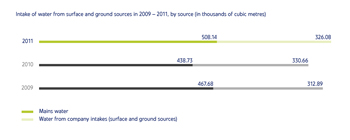Objective 4
To take into account environmental protection criteria when selecting new investment projects, solutions and technologies
In most cases, industrial activity does have an environmental impact. This is usually harmful to the environment; air pollution, water contamination, depletion of drinking water resources and reduced biodiversity are all examples of this impact. For centuries, especially in the industrial era, man exploited the environment to satisfy his needs. However, the emergence of the first material effects of this irrational management of natural resources has brought about a gradual change in attitudes.
The initiatives currently being undertaken on numerous levels share the single common purpose of eliminating or reducing the adverse effects of human activity. This is consistent with the sustainable growth principle, which provides for enough growth to meet the needs of today’s generation without depriving future generations of the ability to satisfy theirs. This principle also drives the PGNiG Group’s pro-environmental initiatives.
Initiatives/best practices
Water and wastewater management
The supply deficit and deteriorating quality of water from domestic sources represent important problems for the PGNiG Group in terms of quality and economic aspects, as well as environmental protection, which is why steps aimed at protecting water resources are of vital importance.
PGNiG Group companies draw water from their own groundwater intake points, or directly from the mains. This water is mainly used for social needs and, to a lesser extent, for industrial processes. Changes in water consumption that are observable from year to year are explainable primarily by the amount of process water used (i.e. the number of exploration and investment projects executed).
In 2011, mains water consumption increased from 438.73 thousand cubic metres to 508.138 thousand cubic metres, while water intake from the company wells has slightly decreased, see the chart below.
Wastewater generated by PGNiG Group entities is discharged to the wastewater system (under contracts with water supply and wastewater collection operators), to groundwater or into the soil (in compliance with existing water permits), following their pre-treatment or full treatment at the Group entity’s own wastewater treatment plants. Household and industrial wastewater is discharged into the wastewater collection system. Rainwater collected on the premises and from access roads is either discharged into the wastewater system or to the groundwater.
In 2011, the volume of wastewater discharged into water and soil increased and the volume of wastewater discharged to the wastewater collection system decreased.



